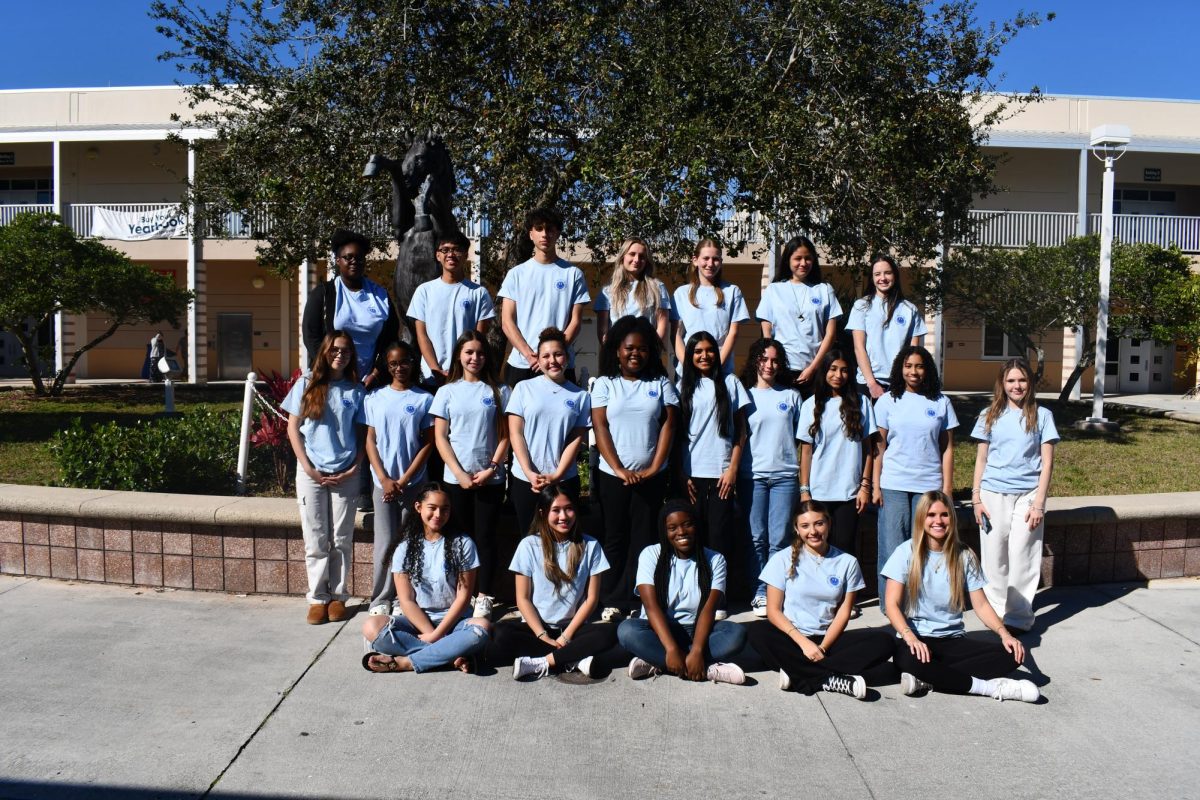Central welcomes students, teachers with major changes
It’s not just dress code this time
October 21, 2020
This is definitely one for the history books. While Palm Beach Central prompted students to make the most of virtual learning during August, faculty has also worked to make the especially unique return to brick and mortar the safest and most sanitary yet, sparking major changes to the Bronco experience for students, parents, and teachers alike.
On March 13, Palm Beach Central announced that it would take a short break for a seemingly small concern about an illness. What began as simple measures quickly altered the course of the end of the ‘19-’20 and beginning of the ‘20-’21 year like never before. Now, for the first time in 7 months, Palm Beach Central has opened its doors back to students and teachers.
When Palm Beach County decided to move into phase 2 of reopening, students were asked to make a choice with their parents. Students were given the option to continue with virtual learning, conducted mainly through Google Classroom and Google Meet, or go back to brick and mortar, also known as in-school learning. According to The Palm Beach Post, in total, Palm Beach County expected 40 percent of students to go to brick and mortar. On its first day, 24 percent of Palm Beach Central students went back.
“I chose virtual learning because I don’t want to risk going back to school,” said junior Tiffany Ross. “I think the school system needs to settle more things out before allowing students and faculty to go back.”
To answer questions for both students and faculty, the Palm Beach County school district also made available a 30-page document outlining the protocols intended to make schools safe. The booklet answers questions ranging from how lunches would proceed after reopening to the protocols if students tested positive for COVID-19.
“The unprecedented pandemic has entirely changed the culture of the campus and quite honestly how I lead as principal,” shared Principal Edgecomb. “Despite all the challenges, our school is still flourishing with teaching and learning.”
The changes on campus closely follow those specified in the county’s guidebook. Hand sanitizing stations are available at each building corridor; there are now three separate entrances that allow students to enter while still being six feet apart; arrows and signage are used to guide students to walk to the right throughout the halls; the red line has been extended to include all of the courtyard; masks are now a mandatory part of the dress code; and dismissal times are scattered.
Apart from signage to navigate throughout the school, many changes have also occurred inside of classrooms. Classes are set up to hold 20 or more students at 6 feet apart. Students now use a QR code during class as a digital hall pass, and bathroom breaks are only permitted during class time. Students bring laptops and charging devices to join classes over Google Meet.
Lunches and bus rides have also changed from the years prior. Instead of the total lunch area spanning up until the red line halfway through the courtyard, the entire courtyard has now been opened up. Two lines have also been opened outside for students to receive their “grab” and “go” meals. Seating in the cafeteria is only on one side, and students are only allowed to sit in every other seat. Masks are still mandatory unless a student is actively eating and sitting down. For buses, students are still expected to follow social distancing guidelines and wear a mask. Buses are sanitized in between each route, according to the district’s guidebook, and windows are to remain closed.
“Going back will help me stay up,” said junior Lilianna Remillard on her reason for choosing in-school learning. “It’ll be better because I can learn easier and be able to easily ask questions in class.”
Teachers have also had to adapt to new safety guidelines. Instructors are given seven minutes between each class to sanitize their rooms. They now must create a curriculum that benefits both virtual and in-school students. Each in-school teacher has been given a kit of PPEs, or personal protective equipment, to minimize COVID related hazards. They are also required to record their class meeting.
“I cannot let fear hold me back,” said Ms. Moran, a sociology teacher who returned to brick and mortar despite having dealt with underlying medical issues. “I love what I do and didn’t let chemo stop me, so why would I let this?”
A few select teachers, however, have also been approved to work from home because of their underlying medical conditions. Those teaching remotely had to provide documentation from a doctor proving that their health put them at a much higher risk. The District was then tasked to either approve or disapprove their status.
In-school students with teachers who work from home are sent to the auditorium, which is now called the Virtual Learning Lab, for the duration of that period.
In addition to sanitizers and disinfectants, teachers, as well as students, are required to wear protective gear such as masks. The Center for Disease Control and Prevention advises that masks be worn over the nose and against the sides of a face to prevent the person wearing the masks from spreading COVID-19.
Some teachers and staff members, however, are opting to use face shields in place of masks. According to the CDC, face shields are not an adequate replacement for masks due to the little knowledge currently known on the effectiveness of them.
In the event of more students returning back to school, the auditorium, according to Principal Edgecomb, would shift into a location for overflowing classrooms, where students enter on a rotating basis. With an increasing number of students, more teachers would also be permitted to come back to school.
“We are implementing systems as though all 2953 of our students are returning,” reported Ms. Butler, one of Central’s assistant principals. “The changes should flow well despite the number of students reporting back.”
Attendance has also been changed. Virtual students will now find that they are marked with “virtual present” on the student information system, or SIS. Teachers are also told to mark students who opted for in-school learning absent if they join class virtually from home.
Palm Beach County has also set up a chain of command when a student tests positive, allowing for the student or faculty member to remain anonymous. Palm Beach Central also vowed to be transparent with cases and announced its first case of Covid-19 to students and teachers four days after reopening.
“I’d like to assure you that all contact tracing protocols were followed,” informed Principal Edgecomb in an email addressing the case. “Anyone who was in close proximity to this person has been notified.”
Palm Beach County has also unveiled an online dashboard to publicly keep track of Covid-19 cases at each school, separated by students and faculty. According to the dashboard on the county website, by the end of the first week, the total number of cases in Palm Beach County schools was up to 16 (see below for more current information).
Palm Beach Gardens High and Citrus Cove Elementary also reported cases in their first week back. Neighboring counties in South Florida such as Broward and Miami-Dade delayed their in-school reopenings until early October. Miami-Dade County began preparing schools by bringing younger children back first, providing thermometers to each student, and installing air filters in education buildings. All the while, two reopened schools located in Central Florida had to close back down due to an influx of COVID cases among staff and students.
A group of teachers in Palm Beach County has even joined a lawsuit against Palm Beach County calling for schools to return to fully virtual learning, citing that it is unsafe, especially for instructors of younger kids, to work in these environments.
“Honestly, I don’t think there is anything that will make me go back for physical learning at this stage,” said Tiffany Ross.” I’d rather wait until senior year.”
It is evident that Bronco students and staff must settle into the reality of this “new normal.” However, the dedication to keeping in line with Bronco PRIDE can still be seen throughout the halls and on the virtual faces of students.
“Our teachers have been masterful in teaching the required standards and maintaining a growth mindset, especially with so much new technology in the classroom,” noted Principal Edgecomb. “Our goal has not changed. We will continue to provide a world-class education to all students. I’m convinced that I have the staff to make this vision a reality. We are truly stronger together!”
*as of November 9, Palm Beach County School District reports there are 440 confirmed cases (201 are employees and 239 are students). Palm Beach Central has 19 confirmed cases (5 are employees and 14 are students).




Darren Edgecomb • Dec 11, 2020 at 11:49 am
This is indeed one for the history books. I believe 20 years from now, history will show that Palm Beach Central High stakeholders pulled together and handled this crisis with success. Our teachers and staff have been outstanding. In addition, our students and parents have showed great resiliency and flexibility.
Isabella, the article is extremely well written.
Very Proud Principal,
Mr. Edgecomb